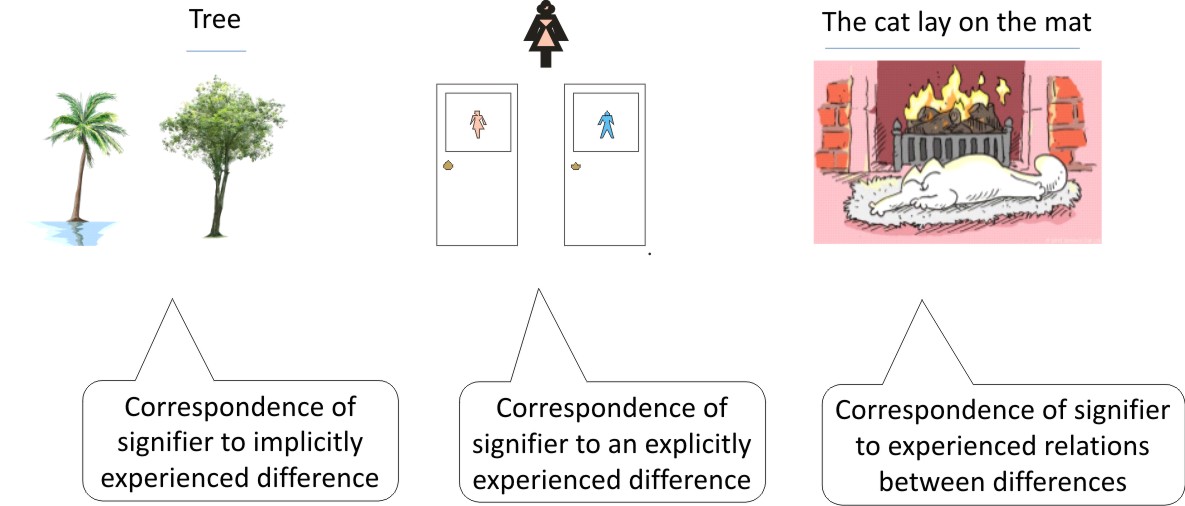The previous four blogs on the missing subject-ego relation, symbol formation, sophisticated groups and matrices of thought raise a question of how we are to understand ‘container’ in a structural sense. This blog aims to clarify how this word ‘container’ is read in terms of ‘signifiers’, ‘signifieds’, ‘formation’ and the Peircean notion of ‘Thirdness’.[1]
The relationship between signifiers (S) and what is signified (s) by those signifiers[2] is written as S/s. The horizontal bar (shown here as a diagonal slash) is used to represent the particular relation of the signifier to that-which-is-signified, and Thirdness refers to the way in which this particular relation to that-which-is-signified is experienced as shared[3]. Thirdness is thus a way of referring to the experience of shared assumptions and constraints acting as the context within which there is an experience of shared meaning, and is therefore some function of S, written as f(S). This function has the effect of placing what-is-being-experienced under a signifying bar (the diagonal slash here) as that-which-is-signified. The effect of this function is to subject what-is-being-experienced to the signifier through a vertical relation to the signifier.[4]

Thus in the figure above, the signifier ‘Tree’ invokes an implicit difference between ‘this’ tree and others, whereas the ‘Ladies’ signifier invokes an explicit difference in the way two rooms are used. How many times have we had to check the images on two identical doors before being sure which one to enter? Finally the signifying chain ‘The cat lay on the mat’ is read as signifying a number of relations between signifiers, to which the experience itself is subjected.
Using this formalisation of S/s, two variations are possible, associated with metonymy and metaphor:
- With metonymy horizontal linkages between signifiers are themselves taken to signify, for example “can I have a cup [of tea]”, so that there is an implicit signification (the contents of the square brackets in the example). Thirdness applied to this metonymy, i.e. to the horizontally linked signifiers, results in a new signifier that, when related to as such, places some implicit experience under a signifying bar.[5] For example, the ‘slip of the tongue’ is taken as referring to something under the signifying bar, psychoanalytic work being interested in what this might be.
- With metaphor, a vertical signifying relation is applied to signifiers that is itself taken to signify, for example, “my life is like a pancake” i.e. Thirdness applied to the vertically linked signifiers imposes a crossing of the signifying bar in a particular way.[6] In the figure above, ‘the cat sat on the mat’ signifying chain functions as a metaphor organising the particular relations between the individual signifiers of ‘cat’, ‘mat’ etc.
Thirdness therefore becomes a particular way of attributing signification to signifiers that have been put into horizontal (metonymic) and vertical (metaphoric) relations to each other, made manifest through speech acts.
Using these concepts, we can return to the notion of the introjected mother-container in the blog on sophisticated groups. This mother-container can now be understood as the child taking up a particular function of Thirdness through which the child establishes a capacity for mental space. The notion of a ‘space’ here is itself a metaphor for the way in which the Thirdness ‘contains’, which can be re-presented as a ‘formation’ of signifiers – a particular way of organising the relationships between object-signifiers and between organisations of object-signifiers and signified-objects.[7]
Armed with this understanding of ‘containment’ as ‘Thirdness’, we need to develop a structural understanding of the effects of meaning described by the function of Thirdness. To do this, we need to look more closely at Freud’s Project and see how Bion’s reading of it left out important structural characteristics. Adding these back in allows us to understand how there might be an unconscious valency for particular organisations of Thirdness aka ‘formation’ as well as for particular forms of symbolic equation.
Next: getting caught inside particular forms of thirdness
Notes
[1] The subject’s experience of a ‘shared mental model’ may be expressed as a relation to ‘Thirdness’, a way of referring to a shared set of assumptions and constraints that structure relations, creating the experience of subjection through the way a role is taken up. See Murphey, M. G. (1993). The Development of Peirce’s Philosophy, Hackett Publishing Company on Thirdness, and Benjamin, J. (2009). “A relational psychoanalysis perspective on the necessity of acknowledging failure in order to restore the facilitating and containing features of the intersubjective relationship (the shared third).” International Journal of Psychoanalysis 90: 441-450 on a relational understanding of this relation to Thirdness.
In the understanding of Thirdness used in this blog, particular importance will be attached to Peirce’s later understanding of ‘irremediable vagueness’, elaborated in Ochs, P. (1998). Peirce, pragmatism and the logic of scripture, Cambridge University Press. This irremediable quality is crucial to understanding the effects of the unconscious on double subjection, underpinning the way in which a ‘formation’ is always lacking…
[2] A useful introduction to these concepts is to be found in Guirard, P. (1975[1971]). Semiology. London, Routledge & Kegan Paul.
[3] Lacan, J. (2006[1966]). The Instance of the Letter in the Unconscious or Reason Since Freud. Écrits: The First Complete Edition in English. New York, W.W. Norton & Co. p414
[4] By expanding S/s, this effect of subjection can be written as f(S) 1/s ibid p428.
[5] This can be written as f(S…S’)S equivalent to S(-)s, ibid p428
[6] This can be written as f(S’/S)S, equivalent to S(+)s ibid p429
[7] The significance of a spatial metaphor being its imaginary characteristics and easy ‘fit’ therefore with the notion of boundaries as used in Bion’s definition of the workgroup – see matrices, mattresses and the relation to the referent group.